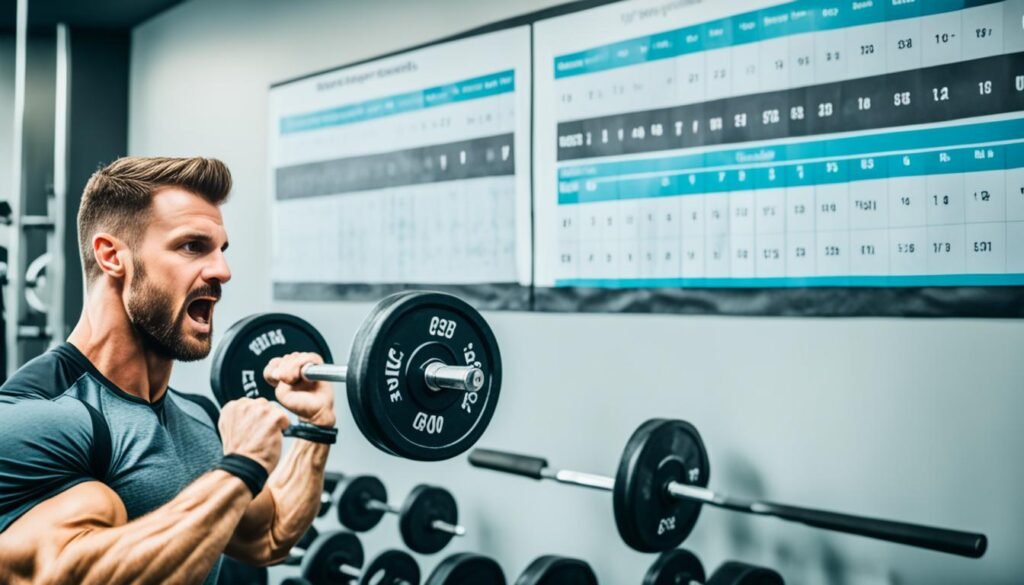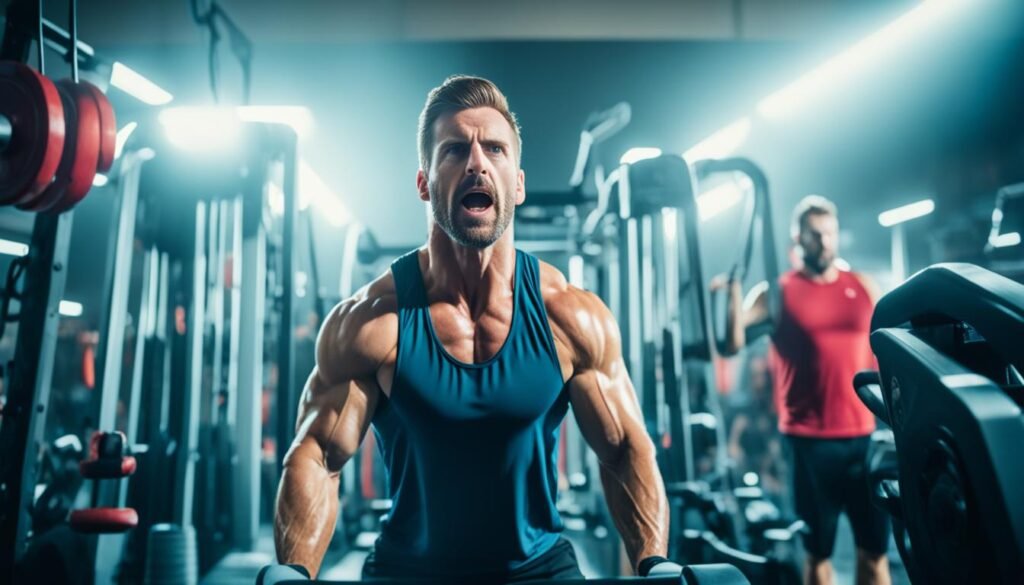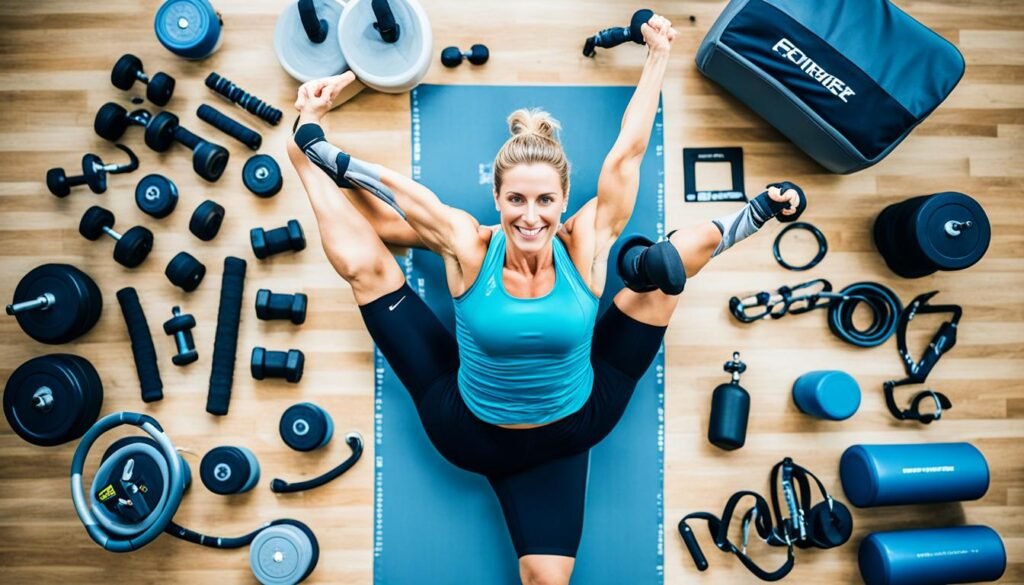Ever felt like your gym efforts aren’t paying off? Hitting a plateau is more common than you might think. It’s key to know how to break through these barriers to keep moving forward in your fitness journey. This article will cover strategies to help you beat plateaus and keep aiming for your dream body.
Fitness plateaus can be really tough, making you doubt your workout and diet plans. I’ll share insights on what causes plateaus, how to spot them, and ways to dodge them. These fitness progress tips are for everyone, whether you’re a pro athlete or just starting out.
Key Takeaways
- Understanding the reasons behind fitness plateaus is essential for progress.
- Signs of a plateau can include lack of progress and decreased motivation.
- Implementing changes in your routine effectively helps to overcome plateaus.
- Rest and recovery play a vital role in preventing fitness stagnation.
- Nutrition strategies can significantly influence your ability to break through plateaus.
Understanding Fitness Plateaus
A fitness plateau happens when I see my performance stay the same even after sticking to my workout plan. This means my body has gotten used to the exercises I do. It’s important to notice these plateaus to keep making progress and reaching my goals.
To beat a fitness plateau, I need to check my workout plan often. Making changes is key to keep challenging my body and growing. By overcoming workout plateaus, I can keep moving forward in my fitness journey.
Knowing why I hit a fitness plateau helps me figure out how to get past it. To keep going, I need to try new things, change my exercises, and focus on recovery. Always checking and changing my approach will help me break through these barriers. This way, I won’t get stuck in my fitness journey.
Why Do Fitness Plateaus Occur?
Fitness plateaus happen for many reasons, especially for those trying to reach their fitness goals. I’ve faced challenges that come from my body adapting to the same routine, not getting enough rest, and what I eat affecting my progress.
Adaptation to Routine
Doing the same exercises over time makes my body get used to them. This means I burn fewer calories and see less muscle growth. Adding variety to my workouts helps keep my efforts effective.
Overtraining and Inadequate Recovery
Not giving my body enough rest after workouts leads to overtraining. This can make me feel burnt out and tired, which slows down my progress. Finding the right balance between working out and resting is key to moving forward.
Nutritional Influences on Progress
What I eat is crucial for my fitness goals. Eating poorly, like not getting enough protein or missing out on important nutrients, can stop me from improving. Understanding how food affects my progress helps me make better choices and overcome fitness plateaus.

Signs You’re Experiencing a Fitness Plateau
Knowing the signs of fitness plateaus is key for those aiming to reach fitness goals. A big sign is a drop in strength gains. If I can’t lift heavier weights or hit my old records, it means I’ve hit a wall.
Not losing weight is another clear sign. If my weight stays the same even with hard work, I know I need to change my routine. Feeling less excited about working out is also a clue. When exercises that once challenged me now feel boring, it’s time to rethink my strategy.
Feeling tired and low on energy is another symptom. If workouts make me feel drained instead of energized, it’s often a sign of a plateau. Spotting these signs early lets me make changes to my training.
For more tips on spotting and overcoming workout plateaus, I can look at the comprehensive terms and conditions online.
How to Avoid Fitness Plateaus
To keep making progress in my fitness journey, I change my routines and try new things. Changing my workout and cross-training have helped me get past fitness plateaus.
Changing Your Workout Routine
Switching up my workout keeps my muscles guessing. I add new exercises every few weeks to keep challenging different muscle groups. This stops my body from getting too used to the same old routine.
This includes:
- Varying exercise types, such as strength training, cardio, and flexibility work.
- Adjusting intensities to ensure I am consistently pushing myself.
- Changing durations of my workouts to include both shorter, high-intensity sessions and longer endurance sessions.
Implementing Cross-Training Techniques
Adding cross-training to my routine has many benefits. It makes me more fit overall and lowers the chance of getting hurt. The main benefits are:
- Improved muscle balance by working different muscle groups.
- Greater enjoyment in my fitness regimen, making it easier to stay committed.
- Increased adaptability, allowing me to switch up my routine whenever necessary.

By using these strategies, I can avoid fitness plateaus and reach my goals.
Effective Plateau-Busting Strategies
To beat fitness plateaus, I use several strategies. Changing my workout schedule is key. I switch up the intensity and add new exercises to keep my muscles adapting and growing. This keeps my body always challenged.
I also use advanced techniques like supersets and drop sets. These methods boost workout intensity and help my muscles grow. They’re key to overcoming plateaus. Plus, I make sure to focus on proper form and recovery to keep making progress.
For more tips, I look at professional advice on breaking through fitness plateaus. This advice helps me stay on track with my fitness goals.
Incorporating Progressive Overload Techniques
Using progressive overload techniques is key for breaking through fitness plateaus and getting stronger. It means I challenge my body regularly to grow and perform better.
Increasing Weight Gradually
As I get better at training, it’s important to increase weight gradually. This keeps my muscles guessing and growing. Slowly adding more weight helps my muscles adapt and prevents my workouts from getting stale.
Changing Repetition and Set Patterns
Switching up set patterns keeps my workouts fresh and effective. Varying the reps and sets changes the intensity of my workouts. This helps avoid plateaus and boosts my fitness level. For more tips, I can check out this resource.

The Importance of Rest and Recovery
I’ve learned that rest is key in my fitness journey. It helps avoid fitness plateaus and supports steady growth. Rest lets my body work well, making me perform better in workouts.
Understanding Muscle Recovery Processes
Rest is vital for muscle recovery. After hard exercise, my muscles need time to fix and get stronger. Knowing this helps me balance my workouts. Rest helps muscles repair and lowers stress hormones, which can slow down my progress.
Strategies for Improved Sleep
Good sleep habits have boosted my fitness. Keeping a regular sleep schedule and making my bedroom sleep-friendly helps a lot. Some tips I use are:
- Establishing a regular bedtime and wake-up time.
- Avoiding screens at least an hour before sleep.
- Creating a comfortable sleep environment by reducing noise and light.
These tips help with recovery and make me perform better. For more on rest and recovery, I check out guides like this one on rest and recovery.
| Recovery Aspect | Benefits |
|---|---|
| Muscle Repair | Crucial for strength gains and preventing injuries. |
| Stress Reduction | Helps maintain hormonal balance and mental clarity. |
| Enhanced Performance | Improves efficiency in workouts, reducing fatigue. |
Using these recovery methods is key to my progress and health. Understanding rest and sleep tips helps me keep up with my fitness goals.
Nutrition’s Role in Preventing Plateaus
Understanding nutrition is key to reaching my fitness goals. It helps me break through plateaus. A diet full of macronutrients and micronutrients keeps me performing well and recovering fast.
Critical Macronutrients
Getting the right mix of macronutrients is crucial for my workouts. I make sure to eat:
- Proteins: These help fix and grow muscles, so I eat enough to support my exercises.
- Carbohydrates: These give me the energy I need for hard workouts. I choose complex carbs to keep me going.
- Healthy Fats: These fats are good for my health and help with hormone balance, which is key for recovery and doing my best.
Micronutrient Considerations
Micronutrients are just as vital for my fitness journey. They help my muscles work right and keep me healthy. I check my nutrient levels often and change my diet if needed. This keeps me moving forward.
Learning about nutrition helps me make smart choices about supplements and food. For more on nutrition’s importance, check out this resource.

Cross-Training for Overall Fitness Improvement
Trying out cross-training brings big benefits for my fitness. Mixing different workouts like strength training, cardio, and yoga helps work out various muscles. This not only improves my performance but also lowers the chance of getting hurt from doing the same thing over and over.
Changing up my workouts keeps things interesting and stops me from getting bored. Trying new sports or classes makes every workout a chance to learn and grow. This keeps me excited and ready to try new things, keeping me fully into my fitness journey.
Adding different exercises to my routine helps me avoid hitting a plateau. Cross-training keeps things fresh and lets me learn new skills. It helps me keep making progress and understand how to make my workouts better for lasting results.
For more on why cross-training is key, check out resources that explain its benefits. Adding cross-training to my daily routine has really helped. It shows how cross-training benefits can make a big difference for anyone into fitness.
Professional Guidance: Working with a Personal Trainer
Working with personal trainers gives me a big boost in reaching my fitness goals. They offer a tailored approach that helps me overcome challenges. This is especially true for those aiming to improve performance and reach specific goals.
Benefits of Customized Programs
One key advantage of professional guidance is the customized fitness programs they create for me. These programs match my unique needs and goals. A trainer spots my strengths and weaknesses, focusing on them effectively.
This personalized approach speeds up my progress and lowers the chance of getting hurt. Here’s a table showing how customized programs help my fitness journey:
| Aspect | Standard Programs | Customized Fitness Programs |
|---|---|---|
| Goal Alignment | Generic goals | Specific goals tailored to my needs |
| Program Adaptability | Fixed routines | Dynamic adjustments based on progress |
| Feedback | Limited updates | Regular constructive feedback for improvement |
| Injury Prevention | Higher risk due to lack of guidance | Focused on safe and effective movements |
Accountability and Motivation from Trainers
Another great reason for working with personal trainers is the accountability and motivation they offer. Being with a pro helps me stick to my fitness plan and keeps an eye on my progress. They push me to go beyond my limits and make important changes when needed.
This outside support builds a mindset of never giving up, making fitness both fun and rewarding.

Mental Resilience in Your Fitness Journey
Building mental resilience in fitness is key to overcoming challenges and hitting plateaus. This strength helps me push through tough times and stay on track with my goals. Using positive self-talk and visualization boosts my commitment and how well I perform.
Positive Self-Talk Techniques
Adding positive self-talk changes my mindset. I stop worrying about doubts and focus on uplifting thoughts. Saying things like “I am capable,” or “I can achieve this,” lifts my motivation. These mantras keep me driven on my fitness path.
Visualization of Goals
Visualization is a great motivator. Seeing myself hit fitness goals makes me feel accomplished before I even do it. It sharpens my focus and boosts my confidence in what I can do. Through vivid images, I remember the rewards of sticking with it and working hard.

Setting SMART Goals for Fitness Success
Creating effective plans is key to my fitness journey. By setting SMART goals, I can focus my efforts well. The SMART method has five parts—Specific, Measurable, Achievable, Relevant, and Time-bound. These help me set clear fitness goals.
Defining Your Fitness Objectives
Having clear fitness goals is crucial for my workout success. Specific goals help me stick to my plan. They let me know exactly what I want to achieve, like better endurance or more strength.
For tips on setting good fitness goals, I suggest looking at this resource.
Tracking Progress Effectively
It’s important to keep track of my progress to stay motivated. Using fitness apps or journals helps me do this. Seeing my improvements over time keeps me committed to my goals.
Regularly checking my progress helps me stay focused. It also lets me make changes if needed.

The Role of Consistency in Achieving Fitness Goals
Being consistent with workouts is key to reaching fitness goals. I know that sticking to regular exercise routines leads to lasting results. By keeping up with workouts, I create a space for growth and betterment. Having a steady schedule makes fitness a big part of my everyday life.
Being on a fitness path means doing strength training, cardio, and flexibility exercises. I try to balance these activities well. Eating right and recovering well also help my fitness journey. These habits make my consistent efforts more effective.
Every workout adds to the next, showing why sticking with it is vital. Knowing that steady effort, not just random workouts, brings real change keeps me going. Over time, I see how sticking with it pays off, showing the power of being consistent.

| Aspect | Description | Importance |
|---|---|---|
| Regular Workouts | Sticking to a schedule that incorporates a variety of exercises | Builds endurance and strength over time |
| Healthy Nutrition | Eating a balanced diet tailored to support active living | Provides nutrients essential for recovery and growth |
| Rest and Recovery | Incorporating rest days and adequate sleep | Prevents burnout and promotes muscle repair |
In summary, my success in achieving fitness goals relies a lot on being consistent with my workouts. Every dedicated session moves me forward. It’s important to stick with a routine that helps me grow and stay strong.
Exploring Various Workout Techniques
Improving my fitness journey means trying out new workout techniques. These new ideas keep my workouts exciting and boost my motivation. It’s important to mix things up to avoid getting bored and stay motivated.
Incorporating Fun Activities
It’s key to keep exercise fun. I’ve found that adding fun fitness activities like Zumba, kickboxing, or outdoor games makes my workouts better. These activities make exercise enjoyable and keep me engaged.
Engaging in Group Classes vs. Solo Workouts
Deciding between group classes and solo workouts changes how I feel about fitness. Group classes help me connect with others and get motivated. On the other hand, solo workouts let me tailor my exercises to my needs. I like to mix both to keep things interesting.

Switching between these options helps me reach my fitness goals. Whether I’m in a group class or working out alone, each choice helps me push past obstacles. For more tips on beating fitness plateaus, check this guide.
Adapting to Changes in Your Body
As I keep going on my fitness journey, I realize how important it is to adjust my workout plans. My body changes over time, and so does how I respond to exercise. This means I need to keep my fitness plans flexible.
When my fitness level changes, what works for me might not work as well anymore. So, I need to try new things to keep getting better.
The Need for Flexibility in Plans
Being flexible with my fitness plans is key to staying motivated and reaching my goals. It helps me:
- See when certain exercises stop working for me.
- Try different training methods to keep things interesting.
- Change how hard I push myself to fit my current fitness level.
- Use recovery methods that suit my body’s needs.
Knowing when to change my approach helps me stay strong in my fitness journey. I can make my workouts better by watching how I progress and being open to changing my goals or methods.

| Strategies for Adapting Workout Plans | Benefits |
|---|---|
| Regularly check my fitness goals | Makes sure they match what I can do now |
| Try out new types of exercise | Keeps things fresh and helps me grow |
| Use different rest days | Helps with recovery and stops burnout |
| Pay attention to nutrition changes | Helps with energy and muscle recovery |
By being open to change, I can use body changes in fitness to get better and perform better.
Conclusion
Overcoming fitness plateaus means understanding their nature and using effective strategies. Throughout my fitness journey, I’ve learned that challenges are a normal part of it. But with commitment and flexibility, I can get past these hurdles and keep moving forward.
Reflecting on my fitness journey helps me see what works best for me. By looking at my routines and how my body reacts, I can make changes that help me grow. This might mean adding more weight to my lifts, eating better, or resting more. Every change helps me reach my fitness goals.
This journey is about more than just getting fit. It’s about growing as a person and staying strong. By facing fitness plateaus head-on and using what I know to get past them, I stay on track. This approach helps me keep improving and aiming for the best.

